🧬 AP Biology Unit 5 (copy)
8-11% AP Weighting
Topics
5.1 Meiosis
5.2 Meiosis and Genetic Diversity
5.3 Mendelian Genetics
5.4 Non-Mendelian Genetics
5.5 Environmental Effects on Phenotype
5.6 Chromosomal Inheritance
5.6 - Introduction to Chromosomes and Reproduction
Humans have 23 homologous/homolog (same) chromosome pairs, meaning 46 total chromosomes.
A decent chunk of 5.6 is more or less vocabulary:
Somatic cells - A normal “body” cell that (in humans)
Gametic Cells - Egg or sperm in humans, cells with half the chromosomes of normal cells that are used for reproduction.
Haploid Cell (Gametophyte) - a cell with half the normal amount of chromosomes, they have a single of each type of chromosomes instead of homologous pairs
Diploid Cell (Sporophyte) - A cell with 2 chromosomes per type of chromosomes, they have homologous pairs.
n - a notation for the number of chromosomes in a cell. A haploid (gamete) cell has n chromosomes while a diploid (somatic) cell has 2n chromosomes.
Syngamy - The fusion of two gametes for fertilization
Zygote - a fertilized egg, diploid.
Allele - the name for the variations of genes. For example, a flower can have an allele for blue petals or an allele for white flowers.
Loci/Locus - the position where a gene/allele is found on a chromosome.
Sex Chromosomes - the Chromosomes that determine the gender of the cell. In humans, there are XY or XX (with the exception of mutations causing intersex, like XXY, XXXY, etc)
Monosomy - The term for when a mistake occurred in meiosis, called a nondisjunction, causing a cell to only have 1 chromosome and not a chromosomal pair. Most of these are not viable, however, a monosomy of Sex Chromosomes causing there to only be a X chromosome is generally a viable female. This is because in females, one X chromosome is “crumpled up” and deactivated into a Barr Body, as there is no need for two X chromosomes.
Tetrad - A pair of homologous chromosomes
Humans remain as diploids their whole life after fertilization, the only human cells that are haploid are the gametes. However, some types of fungi and protists spent the majority of their life as haploids. Some plants, mostly algae, have a life cycle of Alternation of Generation in which they flip between haploid and diploid throughout various stages of their life.
5.1-5.2 - Meiosis
Click Here for a video on Meiosis
Meiosis is the process of reduction division, it creates 4 daughter gametes that are genetically different from the parent cell. Meiosis occurs in 2 steps, Meiosis 1 and Meiosis 2. Daughter cells have half the genetic material of the parent cell. Meiosis begins by duplicating the DNA but divides twice.
Meiosis 1
Chromosomes begin, before Meiosis, as one / in the X, but they are still called chromosomes. During the S phase of the cell cycle, these chromosomes duplicate, so they are now an X, still one chromosome, but with two identical sister chromatids
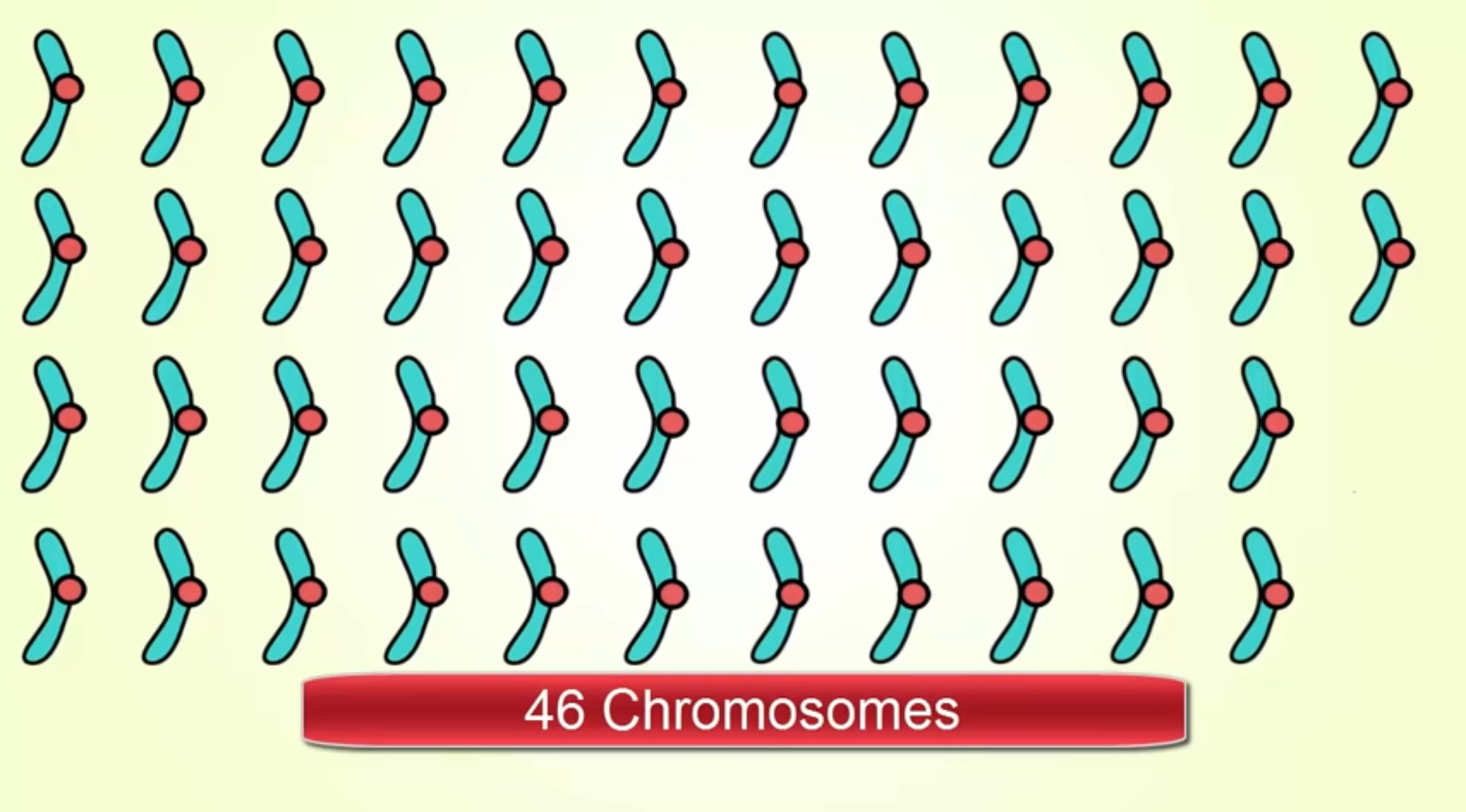
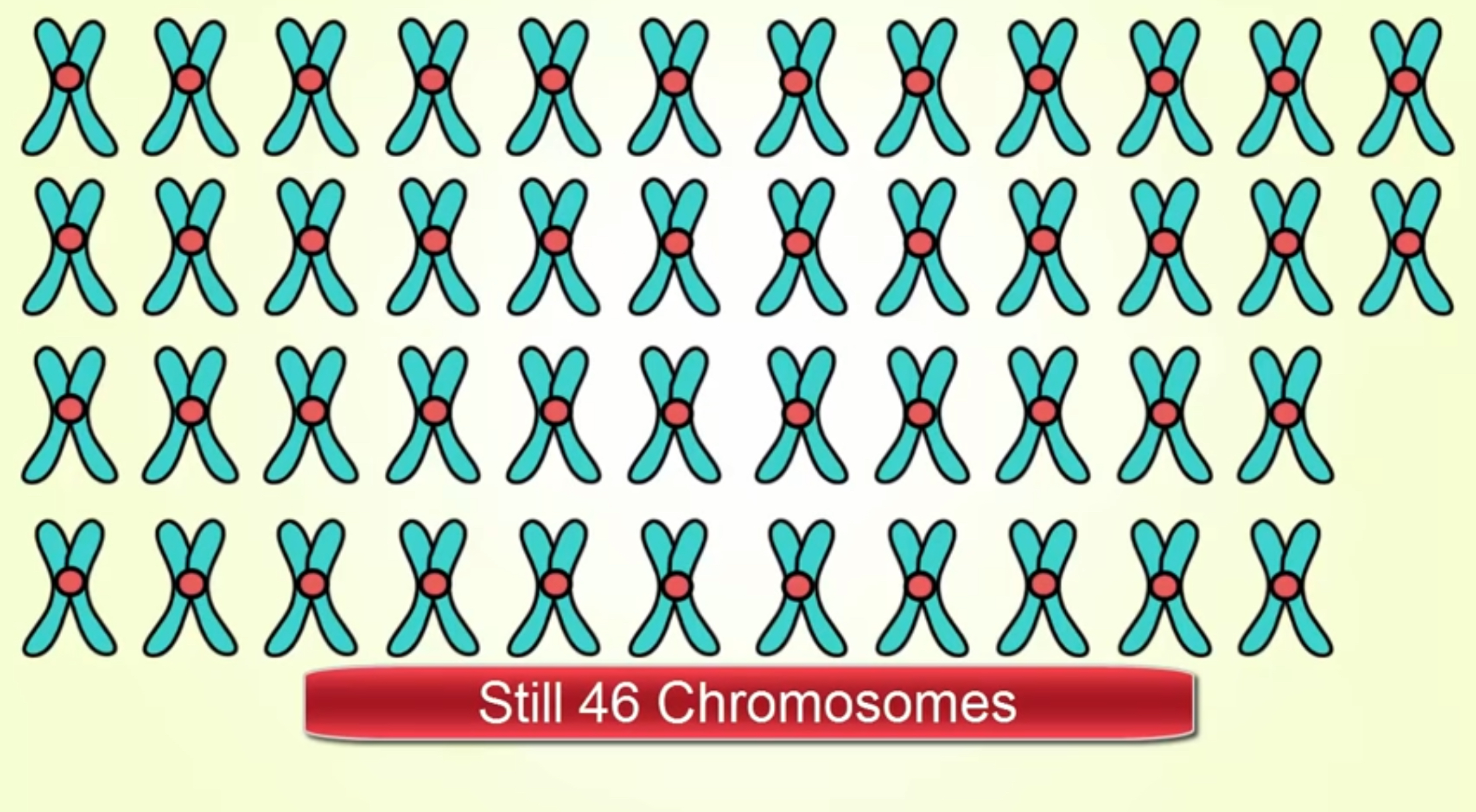
Both chromatids are genetically identical, but their homologous pair, while having the same genes, may have different alleles. Crossing over occurs between the homologous chromosomes, aka between a tetrad, not between sister chromatids. Still confused? Here is a video explaining the chromosome/chromatid difference.
Prophase 1
Homologous chromosomes, through synapsis, are attracted to the other pair of that type of chromosome. These tetrads complete crossing over, beginning with the chromosomes drape themselves over each other at their chiasmas. The alleles switch over to the other chromosome, making them genetically different from each other. (The DNA from the mother and father, which were previously separate chromosomes, get mixed together.)
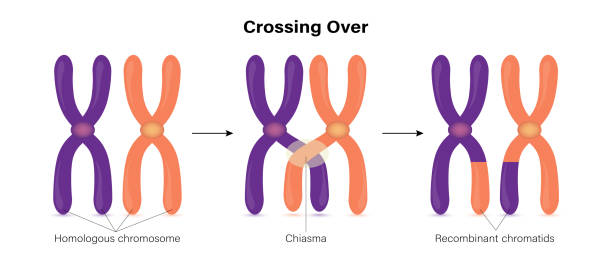
Metaphase 1
The chromosomes line up in the center in random order, called independent assortment. This randomness causes there to be a different combination of the chromosomes in the gametes. In the photo below, their gametes can have different combinations of the chromosomes, which are genetically different from each other.
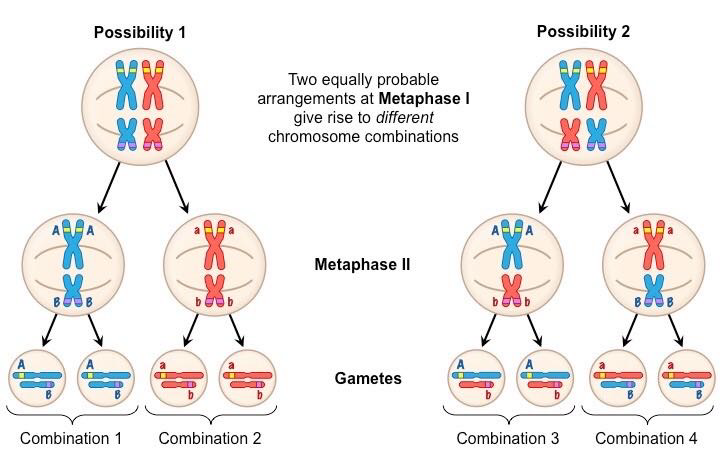
The processes of crossing over and Independent Assortment causes genetic diversity in the gametes.
Anaphase 1
The homologous chromosomes separate
Telophase 1
The cells begin to pull apart, there will be 2 diploid daughter cells.
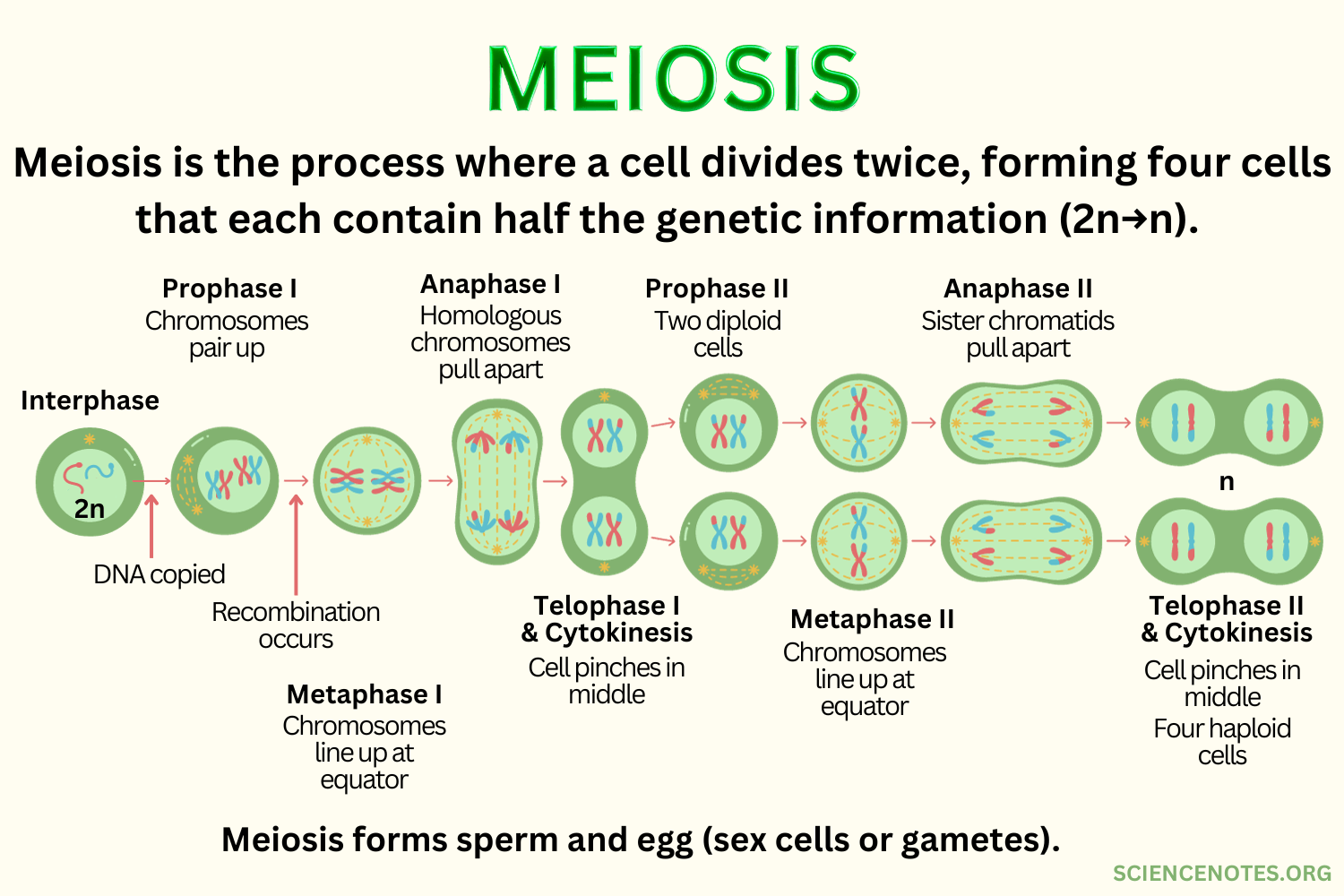
Meiosis II
Prophase II
Spindle fibers form to separate sister chromatids
Metaphase II
Chromosomes line up in the center
Anaphase II
The sister chromatids are pulled apart. Once separated, they are called chromosomes.
Telophase II
The cells begin to split apart, there are now 4 haploid daughter cells, as the 2 daughter cells from Meiosis 1 split into two daughter cells each.
5.3 - Mendelian Genetics
Click Here for videos on Mendelian and Non-Mendelian genetics
Mendelian genetics follow the simple rules of dominant vs recessive.
Dominant
One allele is enough for a certain phenotype to be expressed, the other allele is repressed.
Recessive
Two alleles are required for a certain phenotype to be expressed.
RR or rr - Homozygous; Rr - Heterozygous
Phenotype
The physical expression of the genes
ex: Red petals
Genotypes
The specific alleles
ex: RR
True breeding is the crossing of two homozygous organisms, resulting in offspring of the same phenotype/genotype. (RR x RR or rr x rr)
A Monohybrid Cross is the cross of two heterozygous organisms. (Rr x Rr) These have a 1:2:1 genotype ratio for rr:Rr:RR and a 3:1 phenotypic ratio.
A Dihybrid Cross is a cross of two organisms that are heterozygous for two different alleles. (RrMm x RrMm) These have a 9:3:3:1 phenotypic ratio.
Mendel came up with the Law of Unit Factors, which states there are 2 factors that determine characteristics. These factors are the alleles, but there was not a name at that point. He also created the Law of Segregation, which explains that the parent cells segregate out their alleles and only pass one on to their offspring.
In experiments, Wild Type is the name for the allele commonly found in the wild. It is the non-mutant allele.
Pedigrees
A pedigree is basically a way to do a family tree for genetics. Colored shapes have the trait. Half-colored shapes are carriers. A branch at the children like a triangle means twins, if there’s a line between the triangles they’re identical. A dashed line means adoption/stepsiblings. A diamond with a p means the couple is pregnant, but don’t know the gender of the child. Double lines mean inbreeding.
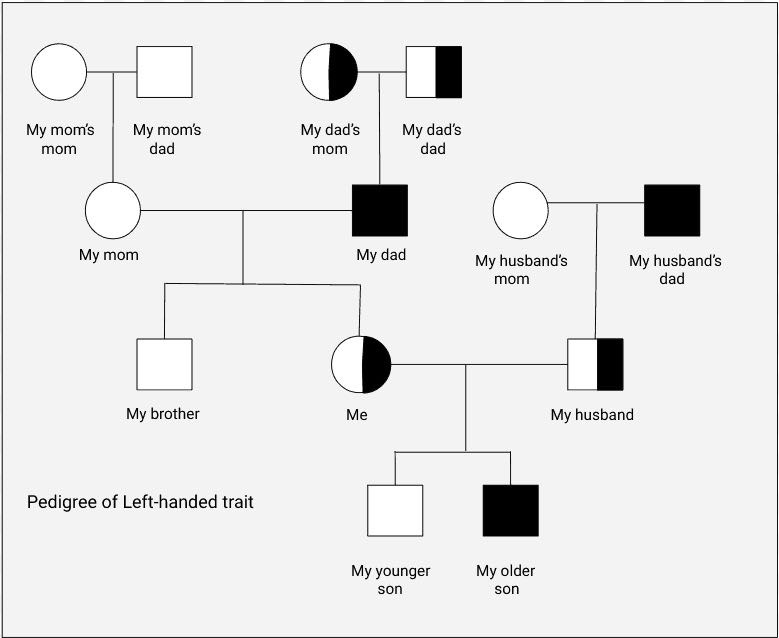
5.4 - Non-Mendelian Genetics
Click Here for videos on Mendelian and Non-Mendelian genetics
Non-Mendelian Genetics are more complicated than simple dominant/recessive, they can be influenced by multiple factors or genes.
Incomplete Dominance: The two phenotypes encoded by the alleles are “blended together,” both are partially expressed. For example, a flower has one red allele and one white allele, so the flower is pink.
Codominance: Both phenotypes encoded by the alleles are expressed in different areas, like spots/patches. For example, a flower has one red allele and one white allele, so the flower has mottled white and red petals. Another example of this is blood types, those with AB blood have both A and B proteins in the blood. O is the absence of A or B.
Pleiotropy: While an allele only controls one phenotype, that phenotype causes effects on other phenotypes. For example, the allele for sickle cell anemia only controls the shape of red blood cells, but sickle cell anemia can cause kidney failure.
Epistasis: One allele alters the phenotypic expression of a completely separate allele. For example, in labradors, there are genes that control fur color, either brown or black. However, there is an allele that partially inhibits pigment production in the fur, causing blonde labradors. Note, this is different from abilities.
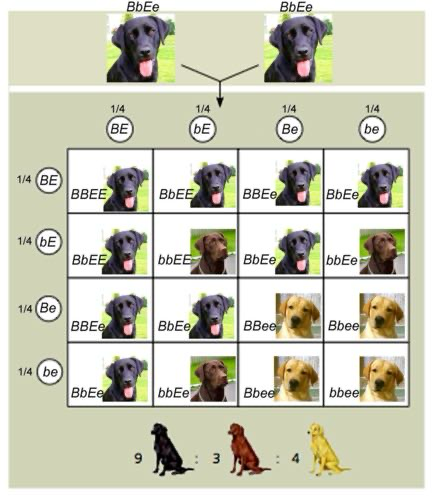
Polygenic inheritance: Multiple alleles control a single phenotype. For example, height, eye color, and skin color all follow this pattern.
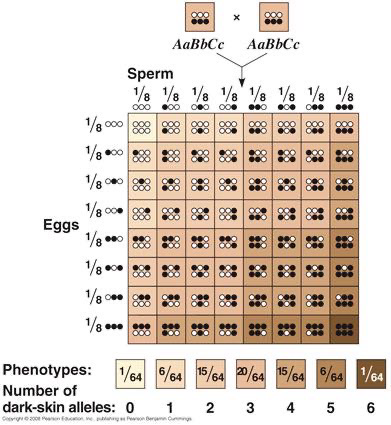
Mitochondrial Inheritance: Mitochondrial inheritance is when traits pass through the maternal lineage via mitochondria. Each gamete receives some mitochondria from the mother. However, if 1 out of every 20 mitochondrial has a mutation causing a mitochondria disease, the mother may asymptotic. Yet, if the child happens to receive more of the mutated mitochondria, they have have 1 in 5 mitochondria diseased and have severe symptoms.
Sex-Linked Trait Inheritance: Sex-linked trait inheritance involves genetic traits on sex chromosomes, the X and Y chromosomes. These traits show different inheritance patterns between males and females due to the genetic makeup of sex chromosomes. X-linked traits are more common in males because they have one X chromosome, while females have two, providing a backup if one trait is harmfully mutated.
5.5 - Environmental Effects on Phenotypes
Click Here for videos on Epigenetics
The environment can cause changes in phenotypes. For example, human skin gets darker when exposed to light over a long period of time, and arctic foxes have a lighter fur color in the winter when there is snow compared to summer. This phenomenon is called phenotypic plasticity. Some forms of phenotypic plasticity are controlled by the regulation of genes, called epigenetics, when some genes are not expressed until exposed to a certain stimulus. This can cause organisms with the same genotype to have different phenotypes because they live in different environments.
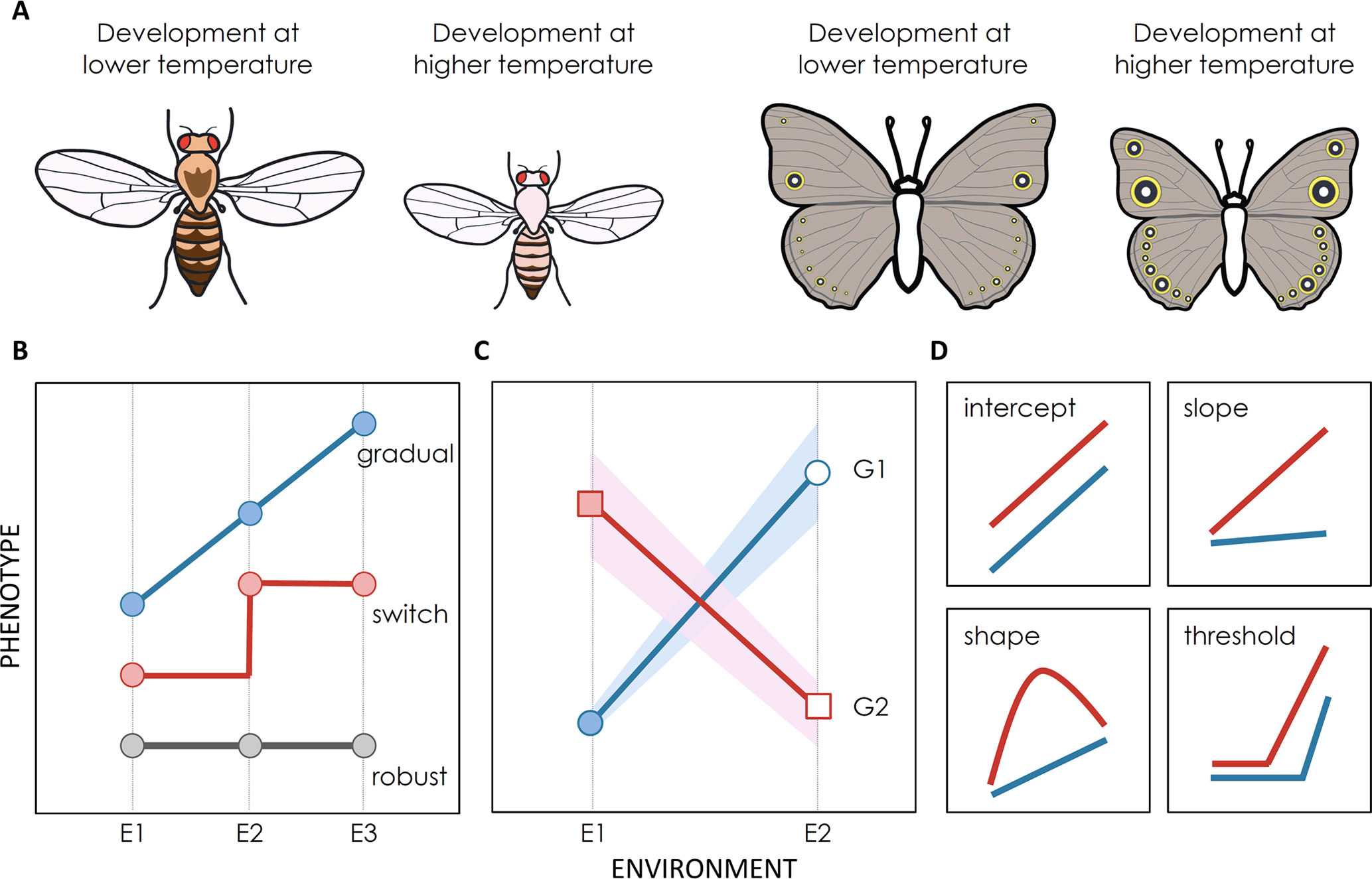
5.6 - Introduction to Chromosomes and Reproduction
Humans' Chromosome Structure: Humans possess 23 homologous chromosome pairs, amounting to a total of 46 chromosomes. Each pair consists of one chromosome inherited from each parent, with homologous chromosomes containing genes for the same traits but possibly with different alleles.
Cell Types:
Somatic Cells: These are the normal body cells in humans, containing the full set of chromosomes (2n). In total, they include all cells except gametes and are involved in growth and tissue repair.
Gametic Cells: Refers specifically to egg or sperm cells, which are haploid (n), meaning they carry half the number of chromosomes (23). These are crucial for sexual reproduction.
Cellular Definitions:
Haploid Cell (Gametophyte): A cell possessing one set of chromosomes (n), as seen in gametes.
Diploid Cell (Sporophyte): A cell that contains two sets of chromosomes (2n), evidenced by the presence of homologous pairs.
Notation: The letter n represents the number of chromosomes. Thus, haploid cells have n chromosomes, while diploid cells have 2n chromosomes.
Key Processes:
Syngamy: This refers to the fusion of two gametes during fertilization, leading to the formation of a zygote.
Zygote: The resulting fertilized egg which is diploid, containing a complete set of chromosomes from both parents.
Genetic Concepts:
Allele: Variations of a gene that dictate specific traits, for instance, a flower can have alleles for blue or white petals.
Loci/Locus: The specific physical position of a gene or allele on a chromosome.
Sex Chromosomes: Chromosomes that determine biological sex in humans, categorized as XX for females and XY for males. Variations in these may result in conditions such as Turner syndrome (X0) or Klinefelter syndrome (XXY).
Monosomy: A genetic condition where a cell has only one chromosome from a homologous pair due to nondisjunction in meiosis. This generally results in developmental issues, though a monosomy of the X chromosome can lead to viable females.
Tetrad: A structure formed during meiosis consisting of four chromatids (two homologous chromosomes). Each tetrad undergoes crossing over, enhancing genetic diversity.
Life Cycle of Organisms: Humans remain diploid throughout their lifespan after fertilization, with gametes as the only haploid cells. In contrast, some fungi and protists exist primarily as haploids, and certain plants exhibit an Alternation of Generations, alternating between haploid and diploid life stages throughout their lifecycle.
Pedigrees in Genetics
A pedigree is a visual representation of familial relationships and the inheritance of specific traits across generations, similar to a family tree. Understanding how to interpret pedigrees is crucial for analyzing inheritance patterns in genetic disorders.
Symbols Used in Pedigrees:
Circles represent females.
Squares represent males.
Colored Shapes indicate individuals expressing the trait.
Half-colored Shapes represent carriers of the trait (individuals who have one allele for the trait but do not express it).
Lines connect parents to offspring, with a branch to indicate twins. If there’s a line between triangles, they represent identical twins.
Dashed Lines signify adoption or step-siblings.
Diamonds with a 'P' denote a couple expecting a child whose gender is unknown.
Double Lines illustrate inbreeding between individuals.
Analyzing Pedigrees:
Determine the Trait: Identify the trait being examined, whether it's a genetic disorder or a specific phenotype (e.g., blue vs. brown eyes).
Identify the Pedigree Structure: Check how individuals are connected to understand the relationships. Parents are placed in the same row, and their children are directly below.
Look for Patterns: Analyze the transmission of traits through the family tree to note whether they follow dominant or recessive inheritance patterns:
Dominant Traits: If a trait appears in every generation, it is likely dominant. Affected individuals usually have at least one affected parent.
Recessive Traits: If the trait skips generations, it is likely recessive. An affected individual can have unaffected parents.
Count Generations: Number the generations (I, II, III, etc.) to track lineage more efficiently.
Calculate Probabilities: Use the pedigree to estimate the probability of offspring inheriting the trait based on parental genotypes. For example, if two heterozygous parents (Rr) have a child, there’s a 25% chance the child will be homozygous recessive (rr). ### Calculate Probabilities in Pedigrees Calculating probabilities in pedigrees helps predict the likelihood of certain traits being passed on to offspring. Below are the steps involved, along with examples for clearer understanding: 1. **Identify Parental Genotypes**: Determine the genotypes of the individuals in the pedigree based on their phenotypes and the inheritance pattern observed. For example, if you know that one parent expresses a dominant trait (like brown eyes), they could be either homozygous dominant (BB) or heterozygous (Bb). - **Example**: If parent A has brown eyes (dominant) and parent B has blue eyes (recessive, bb), you need to ascertain whether parent A is BB or Bb to calculate probabilities. 2. **Use Punnett Squares**: For simple traits, you can use a Punnett square to visualize possible offspring genotypes. For instance, if one parent is heterozygous (Bb) for a dominant trait and the other is homozygous recessive (bb), the Punnett square would look like this: | | B | b | |---|---|---| | b | Bb | bb | | b | Bb | bb | - In this case, there is a **50% chance** of having offspring with the genotype Bb (brown eyes) and a **50% chance** of having bb (blue eyes). 3. **Consider Compound Traits**: For dihybrid crosses (involving two traits), you can use a 16-box Punnett square for more complexity. - **Example**: Cross RrYy (round yellow seeds) with RrYy (round yellow seeds). You would expect: - 9 round yellow (RRYY, RRYy, RrYY, RrYy) - 3 round green (RRyy, Rryy) - 3 wrinkled yellow (rrYY, rrYy) - 1 wrinkled green (rryy) - This yields a **9:3:3:1** phenotypic ratio. 4. **Calculate Probabilities for Multiple Traits**: If traits are independent of each other, you can multiply their probabilities. - **Example**: If Trait A (round vs. wrinkled) has a **1/4 chance** for the aa genotype, and Trait B (yellow vs. green) has a **1/2 chance** for the Bb genotype, the probability for both traits would be: - Probability = (1/4) x (1/2) = **1/8** chance of getting an aaBB offspring. 5. **Use the Pedigree to Estimate Carrier Status**: If one parent is affected by a recessive trait, the other parent may be a carrier. You can gather information from previous generations to make estimations. - **Example**: If parent C is affected by sickle cell anemia (ss) and parent D is normal (could be SS or Ss), by examining the children, if 50% are affected and 50% are normal, you can infer parent D is heterozygous (Ss). 6. **Assess Each Generation**: As you move through generations, see how many offspring show the trait versus those that appear unaffected. This can help refine your understanding of inheritance patterns. - **Example**: If in Generation I, both parents are homozygous recessive for a trait (rr) and produce offspring all exhibiting the trait, then you can conclude the trait is recessive and they will pass it on through their lineage. By implementing these detailed steps and examples, you can better understand how to use pedigrees to calculate trait inheritance probabilities.
Look for Carrier Individuals: Individuals who have the recessive trait may appear to be unaffected but can pass it on to their offspring.
Conclude: Make deductions about the inheritance pattern by summarizing your analyses based on the observed data and patterns of inheritance.
5.6 - Introduction to Chromosomes and ReproductionHumans have 23 homologous chromosome pairs (46 total), including 22 pairs of autosomes (non-sex chromosomes) and 1 pair of sex chromosomes (XX or XY).
Key Vocabulary:
Somatic Cells: Normal body cells (2n) involved in growth and repair.
Gametic Cells: Egg or sperm cells (n), crucial for reproduction.
Haploid Cell (Gametophyte): One set of chromosomes (n), as in gametes.
Diploid Cell (Sporophyte): Two sets of chromosomes (2n), containing homologous pairs.
Syngamy: Fusion of gametes to form a zygote (diploid).
Allele: Variants of a gene (e.g., blue or white flower petals).
Locus: Specific location of a gene/allele on a chromosome.
Sex Chromosomes: Determine biological sex; variations can lead to conditions like Turner syndrome.
Autosomes: 22 chromosome pairs not involved in sex determination.
Monosomy: Condition where a cell has one chromosome from a pair due to nondisjunction, leading to developmental issues.
Tetrad: Structure formed from homologous chromosomes during meiosis.
Humans are diploid throughout life after fertilization, with gametes as the only haploid cells. Some organisms, like certain fungi and plants, alternate between haploid and diploid stages.
Pedigrees in Genetics: A pedigree visually represents familial inheritance patterns for specific traits, utilizing symbols like circles for females, squares for males, and colored shapes for affected individuals. Thorough interpretation of pedigrees aids in understanding genetic disorders and trait inheritance.